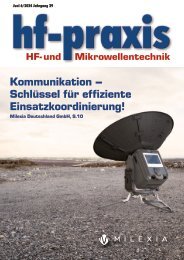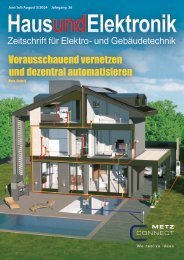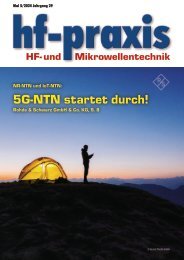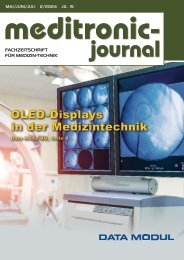5-2019
Fachzeitschrift für Hochfrequenz- und Mikrowellentechnik
Fachzeitschrift für Hochfrequenz- und Mikrowellentechnik
Sie wollen auch ein ePaper? Erhöhen Sie die Reichweite Ihrer Titel.
YUMPU macht aus Druck-PDFs automatisch weboptimierte ePaper, die Google liebt.
RF & Wireless<br />
Concept to Product for a 3D Mesh Antenna<br />
Figure 1: 3D-mesh antenna prototype (silver-coated).<br />
This application note<br />
presents a unique<br />
antenna design based<br />
on synthesis and<br />
simulation technologies<br />
made possible with the<br />
most recent capabilities<br />
found within NI AWR<br />
software.<br />
National Instruments, Co.<br />
www.ni.com/awr<br />
Advancing communication and<br />
sensor technologies for 5G,<br />
internet of things (IoT), and<br />
radar-enabled smart vehicle<br />
applications require more capable<br />
antennas and RF front-end<br />
components, pushing engineers<br />
to create novel designs based on<br />
evolving techniques and materials,<br />
advanced device integration,<br />
and greater exploration of the<br />
design space with unique topologies<br />
and architectures.<br />
Antenna Synthesis<br />
Example<br />
To demonstrate the power of<br />
these emerging technologies, a<br />
3D-mesh antenna was designed<br />
(Figure 1) using AntSyn software<br />
antenna design, synthesis, and<br />
optimization software, which<br />
utilizes genetic algorithms1 and<br />
simulates on Amazon’s computing<br />
cloud. A 3D-mesh antenna<br />
is in the class of evolved antennas<br />
consisting of the rod-shaped<br />
conductor (in straight or 90°<br />
bending), intersected in a way<br />
that is synthesized by a computer-aided<br />
design (CAD) program,<br />
s. references, which can<br />
then be imported into a 3D EM<br />
analysis program such as the<br />
Analyst finite element method<br />
(FEM) simulator for additional<br />
EM verification and tuning. 2<br />
AntSyn software was designed<br />
by antenna engineers to be used<br />
by all levels of experience, from<br />
experts to those who are relatively<br />
new to antenna design.<br />
The self-guiding templates are<br />
intuitive and easy to use, supporting<br />
dozens of antenna types ranging<br />
from spirals to patch antennas<br />
to Yagi and Vivaldi styles.<br />
The straightforward design process<br />
starts with the creation of<br />
a new project and spec sheet,<br />
which enables the user to provide<br />
antenna specifications such<br />
as frequency band, target impedance<br />
match (return loss), gain<br />
pattern, and physical constraints<br />
and materials (if required). The<br />
antenna specifications ultimately<br />
impact the attributes of the<br />
antenna’s physical design.<br />
To generate a physical design<br />
that meets the requirements of<br />
the application, AntSyn software<br />
allows designers to specify<br />
key physical attributes such<br />
as the antenna axis, maximum<br />
size (bounding volume) on the<br />
antenna design, constrain the<br />
antenna geometry size, minimum<br />
and maximum dimensions<br />
for a ground plane, and dielectric<br />
material.<br />
Synthesis results in a number<br />
of candidate antenna designs,<br />
each with an assigned quality<br />
rating that reflects how well the<br />
design met the antenna requirements.<br />
Users can review the<br />
results in the AntSyn software<br />
and then export any of the model<br />
geometries to an EM simulator<br />
of choice for further analysis.<br />
The AntSyn software-generated<br />
structure and the resulting<br />
radiation pattern are shown in<br />
Figure 2.<br />
The Analyst EM simulator offers<br />
a full-3D FEM solver technology<br />
with adaptive volumetric<br />
tetrahedral meshing, direct and<br />
iterative solvers, and discrete<br />
and fast-frequency sweeps.<br />
The software accurately and<br />
rapidly characterizes interconnect<br />
structures, dense circuitry,<br />
and antenna structures of all<br />
sizes, including patch antennas<br />
and antenna arrays on finite dielectrics,<br />
plot near- and far-field<br />
radiation patterns (Figure 3), and<br />
simulates key antenna metrics<br />
such as gain, directivity, efficiency,<br />
side lobes, return loss, surface<br />
currents, and more.<br />
Fabrication<br />
The 3D-mesh antenna, due to its<br />
highly complex structure, can<br />
be costly and difficult to build<br />
using the traditional machining<br />
method, however, it can be easily<br />
realized with 3D printing. The<br />
antenna in this example was<br />
designed to be compatible with<br />
the 3D printer available to the<br />
authors, but smaller and more<br />
complex structures are possible<br />
with alterative 3D printers. The<br />
antenna was designed to operate<br />
between 5 and 5.1 GHz with gain<br />
>5 dBi on the boresight and >3<br />
dBi to 45° off the boresight. For<br />
Figure 2: Synthesized antenna is imported into Analyst software for further<br />
EM analysis.<br />
68 hf-praxis 5/<strong>2019</strong>
















